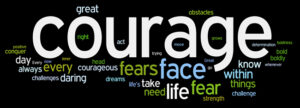How to cultivate courage for our bubble-wrapped kids so they find strength to face adversity and do the right thing.
Empathy Habit #8: MORAL COURAGE Empathy is the miraculous quality that allows us to feel with others, but in order to act on those feelings kids need Moral Courage. Courage emboldens kids to speak out, step in and help others and it is the eighth of the Nine Crucial Empathy Building Habits in UnSelfie. We can cultivate courage. So let’s roll up our sleeves and get started. This is a Brave New World and children will need the skills and know-how to find that inner bravery to do the right thing. To read more about how this habit gives children the Empathy Advantage and how to cultivate it in children, refer to Chapter 8: Moral Courage in UnSelfie: Why Empathetic Kids Succeed in Our All-About Me World.
My favorite movie about courage is, “We Bought a Zoo.” One scene is especially powerful: The teen son admits to his dad that he’s crazy about a girl, but unless he musters the courage to tell her that their relationship is over. His dad’s advice is priceless: “You know, sometimes all you need is 20 seconds of insane courage – just literally 20 seconds of just embarrassing bravery – and I promise you that something great will come of it.”
The truth is that sometimes kids need gentle nudges to step out of their comfort zone and discover their inner strength. Our job is to help our children find their 20 seconds of safe courage, so they can do the right thing when their conscience or heart urge them to step in and help.
Why is it important for kids to be courageous? A bold child is more likely to withstand negative peer pressure, say no to temptations that run counter to your family’s values and fight the good fight.
Courage also has surprise benefits: It boosts kids’ resilience, confidence and willpower as well as their learning, performance and school engagement.
The good news is that courage can be taught.We often make the mistake of thinking of courage as an elusive quality that is locked into our DNA. But my research shows that bravery is made up of teachable skills.
Teaching those skills to our kids – regardless of GPA, gender or temperament (introverts or extroverts) – is how we can help our children learn the skills of courage. And that’s how we raise a generation of caring, courageous children who think WE, not ME.
9 Ways to Cultivate Children’s Courage
Here are nine ways to stretch kids’ risk-taking muscles in our bubble-wrapped world, so they can face adversity and do the right thing:
1. Model courage. Kids who watch their parents stick their necks out to do the right thing are more likely to do the same. Let your child see you step out of your comfort zone, whether it’s tackling your fear of heights or speaking up to your boss. Then express how good it feels when you conquer your fear instead of taking a shortcut. Kids learn how to take on the tough challenges they face from witnessing how you tackle your own fears.
2.Talk about values and courage. Research finds that kids are more likely be courageous if they believe that their parents expect them to support those in need. Discuss bravery with your kids: Tell them, “Courage is making the choice to do what you know is right even if you are afraid.” Some parents develop a family courage mantra like “We find courage to do what’s right, even if it’s hard.” Or you might tell your child, “Our family speaks up and helps others.”
3. Stop bubble-wrapping and rescuing your kids. Always “fixing” children’s problems only makes them more dependent and reduces their ability to bravely seek their own solutions. It also sends a disturbing message: “I’ll help because you can’t do it alone.” If you’re “over-helping,” start building your child’s courage muscles by putting him in the driver’s seat. He – not you – tells his coach he can’t make practice. She apologizes to her pal without your assistance.
 4. Encourage your kids to share their acts of bravery. Learning to be brave takes practice, so encourage your children to do something courageous every day, like introducing themselves to someone new, inviting a new classmate to play or standing up for a peer. Then take time to focus on their courageous breakthroughs. One dad I spoke with had his kids list their “brave successes” on paper strips, then stapled the strips together to make “courage chains.” A mom I talked to had her kids to share their brave deeds at dinner time.
4. Encourage your kids to share their acts of bravery. Learning to be brave takes practice, so encourage your children to do something courageous every day, like introducing themselves to someone new, inviting a new classmate to play or standing up for a peer. Then take time to focus on their courageous breakthroughs. One dad I spoke with had his kids list their “brave successes” on paper strips, then stapled the strips together to make “courage chains.” A mom I talked to had her kids to share their brave deeds at dinner time.
5. Dispel the “Superman myth.” Many kids assume they need to look like a superhero to be courageous. Share stories of those who changed the world with their quiet, nonphysical brave acts. Jackie Robinson, the first Major League baseball black player, was heckled because of his skin color, and showed great bravery by preserving and conducting himself in a professional manner on the field (where he excelled) as well as off it. Mahatma Gandhi – who would go on to be the leader of nonviolent civil disobedience – ran home after school every day, as a child, because he was too shy to talk to anyone. Rosa Parks, the African American Civil Rights activist who refused to give up her seat to white passengers, was described as “soft-spoken … timid and shy.”
 6. Read about courageous kids. Share inspiring news and stories about children who stick their necks out for others. A couple of my favorite books for younger kids are “Courage” by Bernard Waber and “Brave Irene” by William Steig. Check out these titles for older kids: “Wringer,” by Jerry Spinelli and “Stand Up for Yourself and Your Friends” by Patti Kelley Criswell and Angela Martini.
6. Read about courageous kids. Share inspiring news and stories about children who stick their necks out for others. A couple of my favorite books for younger kids are “Courage” by Bernard Waber and “Brave Irene” by William Steig. Check out these titles for older kids: “Wringer,” by Jerry Spinelli and “Stand Up for Yourself and Your Friends” by Patti Kelley Criswell and Angela Martini.
7. Encourage young kids take brave baby steps. Instead of picking her daughter up, a friend of mine helped her 3-year old find courage to cross a small bridge by empowering her. “Be brave, Clara,” she told her daughter. “You can do it.” Clara continued, repeating to herself, “Be brave, Clara!” And she learned something when she crossed the bridge: “I’m brave, Mommy! I’m brave!”
8. Teach kids to prioritize safety. Even as we teach our children to be brave, it’s still important to temper risk-taking. Certainly, we want our children to be safe. So tell your child that safety is always the first priority. If someone could get hurt and the risk is too great, teach your kids to always get adult help or call 911 if needed. Encourage children to trust their instincts, when they have concerns that something is unsafe.
 9. Teach your kids how to reduce their fears. If not kept in check, fear can be overwhelming. Teach your child simple strategies to be brave. You might encourage positive self-talk, such as saying, “I can handle this” or “I have courage to do this.” Or teach your child to take slow, deep breaths to find courage. Research finds younger children are more likely to share their fears with another child. Though you want them to be open with you, let them know it’s also OK to share their worries with a friend. Choose a fear reducer that works best for your child and then help her practice that until it becomes a habit.
9. Teach your kids how to reduce their fears. If not kept in check, fear can be overwhelming. Teach your child simple strategies to be brave. You might encourage positive self-talk, such as saying, “I can handle this” or “I have courage to do this.” Or teach your child to take slow, deep breaths to find courage. Research finds younger children are more likely to share their fears with another child. Though you want them to be open with you, let them know it’s also OK to share their worries with a friend. Choose a fear reducer that works best for your child and then help her practice that until it becomes a habit.
For kids to thrive in today’s uncertain world, they will need courage and confidence. Let’s help them find their hero within and learn to be brave!
Past posts you may find helpful in cultivating children’s thriving potent:
10 Ways to Raise a Charitable Child
Empathy Is a Verb: My TEDx Talk
6 Ways to Inspire Kids To Make a Difference
8 Ways to Help Kids Develop Caring Mindsets
7 Ways to Teach Perspective Taking and Stretch Students’ Empathy Muscles!

Follow me as I share ways we can cultivate our children’s thriving capabilities so handle whatever comes their way.
The ideas and story in this post are adapted from my latest book, Thrivers: The Surprising Reasons Why Some Kids Struggle and Others Shine. It describes how to cultivate the seven essential character strengths that science says stretch our children’s thriving capabilities, and offers 300 strategies parents and teachers can use from toddlers to teens to do so.


